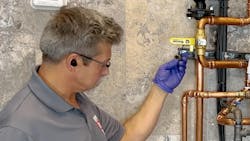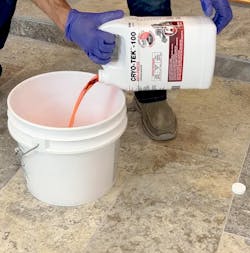Key Factors to Consider When Selecting Antifreeze for Plumbing or Hydronic Systems
- Selecting an antifreeze solution involves more than just freeze protection
- Users need to understand system materials, local climate, dilution requirements, and potential specialty needs
- By considering all these factors, users can help ensure safe, efficient operation and extend the life of the system
Antifreeze is a substance added to a liquid (such as water) to lower its freezing point. It serves several important purposes, such as preventing pipes from freezing and adding corrosion resistance to protect metals. Additionally, it increases the longevity of equipment, making it a valuable asset in various applications. These applications include hydronics, snow melt systems, geothermal energy systems, gas and wood-burning boiler systems, and even systems used by breweries.
Selecting the right antifreeze isn’t as simple as grabbing any jug off the shelf. A wide range of factors should guide the decision, including propylene glycol concentration, pH levels, and freeze-protection points, which can significantly impact system performance and longevity.
Oatey’s Cryo-Tek formulas address all these variables by combining freeze protection with corrosion inhibitors. A patented inhibitor formulation of GRAS additives is combined with virgin propylene glycol (PG) to prevent corrosion and scale, maintain proper pH levels, enhance freeze protection and improve thermal transfer efficiency.
Cryo-Tek offers a wide range of mixtures, from 45% to 97% glycol-to-water ratios, designed for various applications. Unlike most recycled glycol on the market, Cryo-Tek utilizes virgin petroleum-based propylene glycol, proven to outperform organic alternatives. When properly maintained by monitoring pH levels biannually, this product can last over ten years. It is available in sizes ranging from 1 to 275 gallons, ensuring flexibility for different needs.
Below, we break down the key factors to consider when selecting antifreeze for plumbing or hydronic systems.
Propylene Glycol Ratio
When selecting antifreeze, a key factor to consider is the ratio of propylene glycol (PG). This ratio indicates the mixture concentration the antifreeze is formulated at right out of the container. PG is the primary freeze-protection ingredient, often blended with water and additives, such as corrosion inhibitors. For instance, a product labeled “45%” contains 45% PG and 55% water and additives. This mix is frequently diluted further, depending on the application.
Heating system manufacturers typically recommend a minimum glycol concentration, often around 30%, for optimal performance and to maintain the system’s warranty. Therefore, users start with a higher concentration and dilute it on-site with purified water. This helps avoid introducing minerals that could degrade system components.
Products with up to 95% PG should be considered concentrates and would almost always be diluted down from this level. They are typically used in small amounts when topping off systems or correcting diluted mixtures due to leaks.
The amount of PG in the system dictates the level of freeze protection. If there is a need to increase your freeze protection, add the appropriate “concentrated” product to the current solution. This may require contacting technical support. By using a formula, we will incorporate your current freeze protection, account for the overall capacity, and consider your desired final freeze protection level.
Freeze, Flow, and Burst Points
Three critical temperature thresholds help define antifreeze performance:
● Freeze point is the temperature at which the fluid begins to crystallize.
● Flow point indicates the lowest temperature at which the antifreeze can still flow.
● Burst point is the temperature at which the fluid freezes solid and could expand enough to rupture pipes.
For example, an original 45% PG blend might protect down to -22°F undiluted, while a more concentrated 95% version might reach a freeze point near -70°F. The burst point is especially important in worst-case weather conditions, offering insurance against catastrophic pipe damage.
Each product typically comes with a dilution chart that helps you determine protection levels based on its mix ratio. This helps plan around local climate extremes.
For example, Oatey’s technical sheet shows that a 70% concentration of Universal Cryo-Tek™ requires mixing seven parts Universal Cryo-Tek™ with three parts water. This mixture provides freeze protection down to -70°F, remains pumpable down to -80°F, and offers burst protection down to -100°F.
Food Grade Requirements
Some applications require food-grade antifreeze, particularly in breweries or food-processing environments where accidental contact with consumables is possible. These products are formulated with food-safe propylene glycol and high-purity inhibitors, minimizing health risks in these settings.
Color Coding
While antifreeze color doesn’t impact performance, it helps identify products during installation and maintenance. However, discoloration can occur over time due to corrosion or mixing, so color is a helpful, but not a foolproof, indicator. Common product colors include orange, blue, purple and green, with each manufacturer using its own coding.
System Material Compatibility and pH Requirements
pH is a scale used to specify the acidity of an aqueous (watery) solution. The pH of antifreeze directly affects how it interacts with system components. For example:
● Aluminum and galvanized steel require low-pH antifreeze to avoid corrosion.
● Copper and stainless steel systems tolerate higher pH levels without issue.
Cryo-Tek™ Original and Cryo-Tek™-100 are suitable for most systems made with copper, steel, cast iron, brass, PEX, polypropylene, and elastomeric tubing. It offers pH ranges of 8.5–10.0 and 9.0–10.0, respectively.
For systems containing aluminum components, Cryo-Tek™ AL is the better choice; it’s specially formulated with a lower pH range of 7.0–8.5 to help prevent corrosion and material breakdown.
When antifreeze in a system becomes acidic (or has a low pH), it’s recommended to add a corrosion inhibitor like SludgeHammer Universal Corrosion Inhibitor to bring the pH up to its recommended value. When the pH level is too high (alkaline), there is no product available to lower the pH. Therefore, you must flush the system and introduce new antifreeze.
Viscosity and Pumping Efficiency
Viscosity indicates the thickness of the fluid. More concentrated antifreeze has higher viscosity, making it harder to pump through a system. The viscosity is used to size pumps and equipment along with the density of the formula. This is mainly an issue in cold conditions, when you need a product that is only slightly diluted with water. For example, a 95% PG blend has a higher viscosity than a 45% mix, potentially requiring more powerful circulation pumps
Viscosity can significantly influence the rate of heat transfer at the interface of an exchanger. As liquids flow, they create a boundary layer at the surface of the pipe or exchanger, where the flow is slower than in the center of the pipe. The thicker the liquid, the more substantial this boundary layer becomes. Consequently, a denser liquid slows down heat transfer from the metal surface of the exchanger, effectively acting as an insulating layer.
Heat Transfer Efficiency
Propylene glycol does not transfer heat as efficiently as water. The more glycol present, the less efficient the heat transfer, potentially requiring more energy to maintain desired temperatures.
That’s why using only as much antifreeze as needed is essential to protect against freezing, balancing protection with system performance. The Cryo-Tek™ Original has a high heat transfer coefficient (.908), making it excellent for performance-focused applications.
Adding Antifreeze to a Heating System
Blending of glycols: Cryo-Tek glycols are compatible with other Cryo-Tek products. When using glycol for an aluminum system, you need to avoid mixing standard glycols because the pH levels are different and can cause metals to break down over time. The various colors of glycol are used as an identifier of the product and won’t matter if mixed.
When adding antifreeze to a system that is new or empty:
● Determine system capacity
● Determine the desired level of freeze protection
● Based on desired freeze protection, calculate the ratio of antifreeze to water
● Pre-mix antifreeze with water in a separate vessel
● Pump the mixture into the heating system
Adding antifreeze to an existing system:
● Drain system into storage vessel, test, add antifreeze mix, re-introduce into system.
Adding antifreeze to any system:
● Empty the contents of the system
● Ideally, the system should be cleaned before adding antifreeze
● Fill with a restorer, like Hercules Sludgehammer System Restorer & Noise Reducer, and a water mixture
● Run the system according to instructions
● Drain and flush with water
● Reinstall the proper mix of antifreeze and water to fill the system
Selecting an antifreeze solution involves more than just freeze protection. It requires understanding system materials, local climate, dilution requirements, and potential specialty needs. By considering all these factors, users can help ensure safe, efficient operation and extend the life of the system.
About the Author
Sean Comerford
Sean Comerford is the Applications Manager at Oatey Co. He is a third-generation tradesman with nearly 20 years of plumbing experience, including serving as the lead plumber for commercial/residential new construction, service, and fire protection jobs. He holds a State of Ohio Fire Protection License for Sprinkler and Standpipe.

